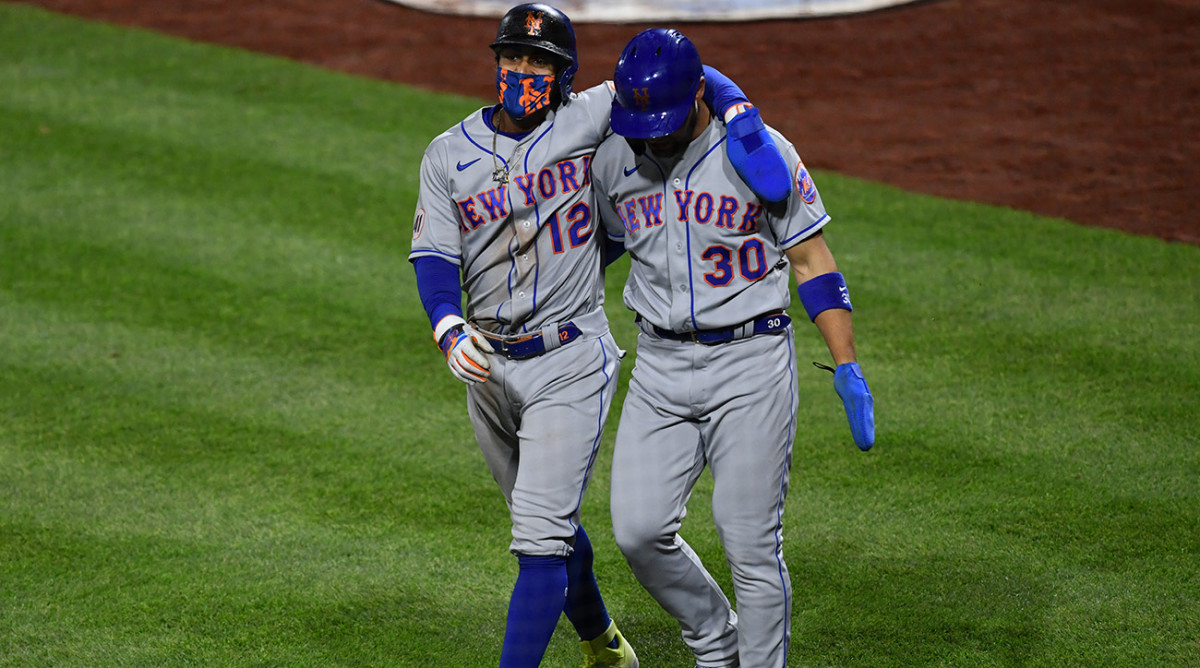The Mets Are in First Place, But 'Big Mets Energy' Is Alive and Well
Welcome to The Opener, where every weekday morning you’ll get a fresh, topical column to start your day from one of SI.com’s MLB writers.
Back in November, when Steve Cohen was approved to take over as majority owner of the Mets, I wrote a column pondering what this new ownership might mean for the team’s Metsiness—the ineffable quality that makes them, well, the Mets.
This quality is not tied to winning or losing. It is not directly tied to the roster or the manager or even the owner. It transcends all of that; Metsiness is a journey instead of a destination. Indeed, the column noted, it felt entirely possible the team would spend the winter marking its new era with a major acquisition—like, say, Francisco Lindor?—and go on to enjoy a successful season all while still keeping a certain Metsiness. This seemed perfectly reasonable: Metsiness was “not tied to a specific sort of action,” the column went. “It was a vibe. It was a spirit. It was getting locked in the batting cage when you’re supposed to be pinch-hitting.”

No one this year has been locked in the batting cage when he was supposed to be pinch-hitting. (Well, no one that we know of, at least.) That detail aside? It’s been made abundantly clear that the baseline competency of new ownership has not, could not, spell the end of "Big Mets Energy." Look no further than the situation for the team right now: The Mets are in first place in the NL East. They have a negative run differential. Lindor has been struggling at the plate all year. The roster is in shambles, stricken by a variety of injuries stunning in both its breadth and its depth. (As of Monday, there were 16 Mets on the injured list, with an additional two who might be sufficiently banged up to be added on Tuesday.) And this is, again, a first-place team—because of chaos elsewhere in the division, sure, but also because that’s the sort of absurdity that is profoundly, inalienably bone-deep in this franchise.
This all led general manager Zack Scott to talk to the media on Monday before the Mets’ game against the Rockies. MLB’s website gave the press conference the understated headline “GM Scott talks Mets injuries, search for help”—accurate both on a technical level (an urgent need to patch up the injured roster is a “search for help”) and a spiritual one (crushing existential doubt is also a “search for help”).
“We’re trying to find the best internal options, the best external options, trying to get the most out of the guys that we have,” Scott said. “It’s really all of the above.”
With internal options, external options, getting the most out of the guys that they have … everything. That is quite literally everything. That is a general manager acknowledging that he has tried everything, which, at this point of the season, when it’s too early either to buy or to sell, is functionally the same as doing nothing.
For Monday night’s game against the Rockies, at first base, you had James McCann, who had never played the position before at any level of professional baseball. (Manager Luis Rojas said pregame that the catcher was “familiar” with first base, the way a nervous job applicant might say he’s familiar with advanced function in Excel.) And McCann revealed himself to be unexpectedly sharp at the position! Meanwhile, in centerfield, you had … in centerfield, you had a lot going on.
You did not have Brandon Nimmo. (A bone bruise on his left index finger has kept him from swinging a bat for weeks.) You did not have Kevin Pillar. (He was recently hit in the face with a 94-mph fastball.) And you did not have Albert Almora, Jr. (He’s suffering from a shoulder contusion after crashing into the outfield wall.) If you’d like to try shuffling around some positions to pull from elsewhere on the depth chart—Michael Conforto can’t move over from right field, because he’s out with a hamstring strain that should keep him sidelined for at least another month, and Jeff McNeil’s outfield experience is unhelpful, too, because he also has a hamstring strain. What you had instead was no choice but to bestow the starting job on rookie Johneshwy Fargas.
In the fourth inning, Fargas crashed into the outfield wall, spraining his shoulder. (The ball skittered out behind him—a triple, which would eventually score, in what became a 3–2 loss for the Mets.) It’s sick, and stupidly improbable, and its own weird form of antihumor: What happens when you have to resort to your fourth-string centerfielder? You end up having to switch to your fifth-string centerfielder! And someone else had his own nonjoke:
Anybody want to suit up?
— Steven Cohen (@StevenACohen2) May 25, 2021
Perhaps this seems like a case of mistaken identity—a team in first place that feels completely antithetical to the idea of a first-place team. Look a little closer, though, and you’ll see that it’s the opposite—a team that, against all odds, is weirdly and improbably and (yes) Metsily true to itself.
More MLB Coverage:
• What's Behind Baseball's Hit-By-Pitch Epidemic?
• The Precarious Case of Joe Ryan and Former College Pitchers
• MLB Power Rankings: Padres, Dodgers Return to Winning Ways
• Want to Solve the Unwritten-Rules Problem? Let Teams Give Up
